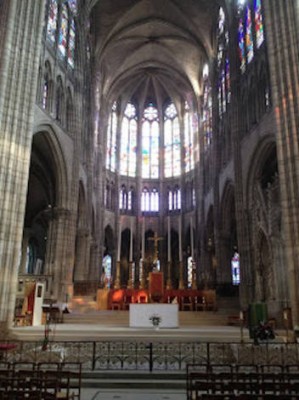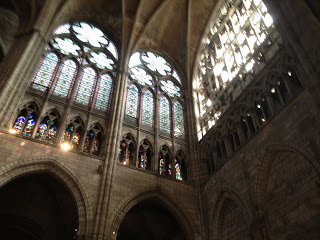PARIS, FRANCE. At the end of the number thirteen metro line, just outside the northern Parisian city limits, lies the commune of Saint-Denis. Located at the spot where Denis, the Bishop of Paris during the 3rd century, is said to have fallen dead following his beheading and subsequent proselytizing, this city has grown around the churches and monastery that have stood at this site since circa 475.

Cathedral Saint Denis
The basilica that now occupies the location was begun in 1135, and was named a cathedral in 1966. In this span of several hundred years, this cathedral has become one of the most important in all of France. It holds the distinction of being the final resting place of the remains of the kings of France. This, combined with the gothic architecture, drew me to spend my Saturday afternoon wandering amongst the tombs of royalty.
The interior of the basilica is amazing, with soaring vaulted ceilings, intricately carved pillars, stained glass in every window, and life-sized statues of the entombed. Similar to Notre Dame, when you walk through the front doors of this church, you truly get a feeling of the wealth and power of the medieval church. To me, the most interesting portion of the church was the crypt, located directly under the main altar. Here is where the kings of the more recent monarchies lie interred (with the exception of Louis Philippe). The difference between the many tombs was surprising. Many of the last Bourbon kings have simply a simple slab of black marble, while Louis XIV, the sun king, has a monument that takes up an entire wall of one of the side chambers. The grandeur and opulence of the building are evident to anyone who steps inside, quite in contrast to the run-down appearance of the Eglise de Saint-Merri. And yet the dichotomy doesn’t only exist on the interior.
The area around Saint-Merri is the 4th arrondissement, part of the heart of Paris. The state of the church seems almost to be a blemish on the busy surrounding area (although with the Pompidou Center right by it, it’s got some competition). Conversely, the area around the basilica has seen better days. Saint-Denis grew as a heavily industrialized area, and in recent years has seen a spike in crime, the rate of which is almost double that of the French average. Walking from the metro to reach the cathedral was an eye-opening journey. I felt somewhat apprehensive as I took in my surroundings, which then, in a 60 second span, morphed from downtrodden to impressive, as the monument came into view around a corner. The contrast was extraordinary. Seeing such a grand basilica located in a neighborhood that has seen better times made me truly wonder if the resources of the church were truly going to the best possible place. A perfect example of how the Church as an organization could follow in the step of Eglise de Saint-Merri and help lift the community.
— Michael Kirsch

